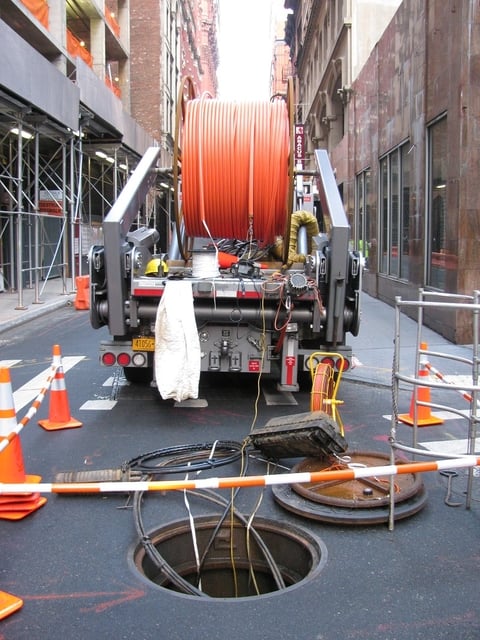Following 2012's Hurricane Sandy, Verizon has put together a new set of flood barrier and network transformation methods that are designed to achieve two goals: keep its wireline network operational and hasten its ongoing copper-to-fiber migration.
During Sandy, which flooded several of its service and COs, the service provider reported $1 billion in damage due to water and related storm damage.
While Verizon always prepares for storms, Kevin Service, SVP of network operations at Verizon, told FierceTelecom that the company did not expect the water to rise so quickly to flood various key switching centers in New York and New Jersey.
RELATED: Verizon blames Hurricane Sandy, other issues for not completing NYC FiOS build out on time
“It was remarkable how fast the water came up and flooded some of these offices,” Service said. “Even though we have generators and backup power to support our network, there’s not a lot you can do when everything is under water.”
Preventative measures

Over the five years since Hurricane Sandy, the service provider is taking what it says are preventative measures in anticipation of future weather events where flooding could occur.
“When you look back at everything that happened and what you can do to prevent it in the future, the first thing you must focus on is how do you protect your assets and prevent the damage caused by water,” Service said. “The poles that blow down are easy to put back up, but when the water gets into your switch equipment and your copper cables, it’s very difficult if not impossible to fix.”
Specifically, Verizon has continued to harden its network environment by taking various steps: moving generators to higher floors and encasing fuel pumps in submarine enclosures.
Additionally, Verizon built a portable nine-foot flood wall around its 140 West Street office in New York City if there’s another storm that could cause water damage.
“This prevents the water from coming into places where we have equipment,” Service said.
Fiber resiliency
Being a 100-plus year old ILEC, one of the big learnings for Verizon during this storm was the damage to its copper network. Once copper wiring gets wet, it is very hard to replace.
In New York City, the service provider’s COs at Broad Street and Bell Harbor in Queens were destroyed. However, the damage at these facilities gave the company an opportunity to transition them all to fiber.

“We’ve spent the better half of the last several years making sure that we got all the copper that comes out of those offices out of the network and completed converted to fiber,” Service said. “There’s no more copper infrastructure left coming out of those central offices.”
What Verizon has found as it has converted more of its COs to fiber is that it has less trouble reports from its customers than it had on its current copper-based networks.
“Our outside plant report rate is about a tenth of what it is on the copper network,” Service said. “When we have storms that roll through other parts of the country and there’s a lot of flooding and water damage, we just don’t see that on our fiber network.”
Service added that the only issues that tend to affect the fiber network are physical cuts, like a tree cutting a cable due to wind.
“The type of water damage we saw we incurred with Sandy won’t affect us the same way in these offices where we are 100% fiber,” Service said. “We have spent a lot of time putting fiber into our network.”
Targeted copper retirement
Given the cost and time it takes retire copper, Verizon is taking a targeted approach by prioritizing its largest markets like New York City first.
In New York City, the service provider has 66 wire centers in the five boroughs. So far, the service provider has converted four that were severely damaged by Sandy but Verizon plans to enable all of them with fiber over time.
“Four of the COs where we have taken a lot of damage from Sandy are further ahead than others in terms of the transformation effort, but all 66 are on our plan to fiberize,” Service said. “This means to take all of the copper out of the network and put fiber everywhere.”
Following Hurricane Sandy, Verizon installed 5,000 miles of fiber and then another 2,000 miles of fiber.
Service said every year “we are putting more and more fiber into that network which will significantly reduce storm damage going forward.”
Outside of New York City, the service provider has continued to retire copper facilities in other parts of its Northeast wireline footprint.
In September, the service provider filed requests with the FCC in towns and cities in the legacy ILEC markets of Virginia, New York, New Jersey, Pennsylvania, Rhode Island, Massachusetts, Maryland and Delaware.
During the process of retiring copper, Verizon lays out a plan what facilities it wants to shut down and then talks to each customer, which is usually a mix of consumers, businesses and other carriers.
“We have consumer customers, we have businesses customers, enterprise customers, and wholesale carrier customers on copper,” Service said. “We have to do a like for like product match to make sure that the product that the customer is purchasing can be provided on fiber.”
Service said that while converting business customers to fiber is a bit more challenging, Verizon has the overall retirement process down to a science. This process includes understanding the product set used, scheduling a time for conversion, installing new facilities in the building, and getting a like for like service.
“Going through the process of every customer served by an office is laborious,” Service said. “As we work through all of that we do it across multiple offices. When we get to point of having 99.9% of the services converted, we’ll start the work of retiring the switch and taking the copper switches out of the network.”
